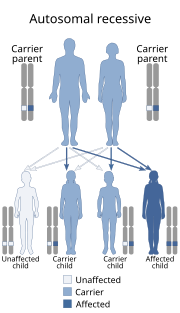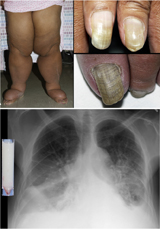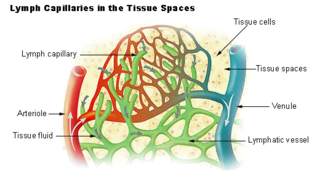
Lymphedema, also known as lymphoedema and lymphatic edema, is a condition of localized fluid retention and tissue swelling caused by a compromised lymphatic system. The lymphatic system functions as a critical portion of the body's immune system and returns interstitial fluid to the bloodstream. Lymphedema is most frequently a complication of cancer treatment or parasitic infections, but it can also be seen in a number of genetic disorders. Though incurable and progressive, a number of treatments can ameliorate symptoms. Tissues with lymphedema are at high risk of infection because the lymphatic system has been compromised.

Elephantiasis is the enlargement and hardening of limbs or body parts due to tissue swelling. It is characterised by oedema, hypertrophy, and fibrosis of skin and subcutaneous tissues, due to obstruction of lymphatic vessels. It may affect the genitalia. The term elephantiasis is often used in reference to parasitic worm infections, but may refer to variety of diseases where parts of a person's body swell to massive proportions.

Aagenaes syndrome is a syndrome characterised by congenital hypoplasia of lymph vessels, which causes lymphedema of the legs and recurrent cholestasis in infancy, and slow progress to hepatic cirrhosis and giant cell hepatitis with fibrosis of the portal tracts.
Lymphangiosarcoma is a rare cancer which occurs in long-standing cases of primary or secondary lymphedema. It involves either the upper or lower lymphedematous extremities but is most common in upper extremities. Although its name implies lymphatic origin, it is believed to arise from endothelial cells and may be more accurately referred to as angiosarcoma.

Yellow nail syndrome, also known as "primary lymphedema associated with yellow nails and pleural effusion", is a very rare medical syndrome that includes pleural effusions, lymphedema and yellow dystrophic nails. Approximately 40% will also have bronchiectasis. It is also associated with chronic sinusitis and persistent coughing. It usually affects adults.
Stewart–Treves syndrome, refers to a lymphangiosarcoma, a rare complication that forms as a result of chronic, long-standing lymphedema. Although it most commonly refers to malignancies associated with chronic lymphedema resulting from mastectomy and/or radiotherapy for breast cancer, it may also describe lymphangiosarcomas that result from congenital and other causes of chronic secondary lymphedema. Lymphangiosarcoma arising from cancer-related lymphedema has become much less common with better surgical techniques, radiation therapy, and conservative treatment. The prognosis, even with wide surgical excision and subsequent radiotherapy, is poor.

Lymphedema–distichiasis syndrome is a medical condition associated with the FOXC2 gene. People with this hereditary condition have a double row of eyelashes, which is called distichiasis, and a risk of swollen limbs due to problems in the lymphatic system.
Chronic progressive lymphedema (CPL) is a disease of some breeds of draft horse, whereby the lower legs becomes progressively more swollen. There is no cure; the aim of treatment is to manage the signs and slow progression of the disease. The cause of CPL is not known, although it is suspected that a genetic disorder of elastin metabolism prevents the lymphatic vessels from functioning properly, leading to edema of the lower limbs. CPL resembles the human disease elephantiasis verrucosa nostra.
Lymphatic disease is a class of disorders which directly affect the components of the lymphatic system.

Milroy's disease (MD) is a familial disease characterized by lymphedema, commonly in the legs, caused by congenital abnormalities in the lymphatic system. Disruption of the normal drainage of lymph leads to fluid accumulation and hypertrophy of soft tissues.

Lymphedema praecox is a condition characterized by swelling of the soft tissues in which an excessive amount of lymph has accumulated, and generally develops in females between the ages of nine and twenty-five.This is the most common form of primary lymphedema, accounting for about 80% of the patients.
Secondary lymphedema is a condition characterized by swelling of the soft tissues in which an excessive amount of lymph has accumulated, and is caused by certain malignant diseases such as Hodgkin's disease and Kaposi sarcoma.
Bullous lymphedema is a skin condition that usually occurs with poorly controlled edema related to heart failure and fluid overload, and compression results in healing.
Factitial lymphedema is a skin condition produced by wrapping an elastic bandage, cord, or shirt around an extremity, and/or holding the extremity in a dependent and immobile state.
Elephantiasis nostras is a cutaneous condition, a final hypertrophic fibrosis following longstanding chronic lymphangitis.

Hennekam syndrome also known as intestinal lymphagiectasia–lymphedema–mental retardation syndrome, is an autosomal recessive disorder consisting of intestinal lymphangiectasia, facial anomalies, peripheral lymphedema, and mild to moderate levels of growth and intellectual disability.
Primary lymphedema is a form of lymphedema which is not directly attributable to another medical condition.
Hypotrichosis–lymphedema–telangiectasia syndrome is a congenital syndrome characterized by lymphedema, the presence of telegiectasias, and hypotrichosis or alopecia. Lymphedema usually develops in the lower extremities during puberty. Hair is normal at birth, but usually lost during infancy. Telangiectasias may present on the palms and soles more commonly than on the scalp, legs, and genitalia. The syndrome has been reported in association with both autosomal dominant and autosomal recessive inheritance patterns.
Dahlberg Borer Newcomer syndrome is a rare autosomal X-linked recessive genetic condition characterized by a prolapse of the bicuspid valve, progressive kidney failure, congenital lymphedema, hypoparathyroidism, and very short end bones of fingers. Treatment for this condition is based on its symptoms. These treatments may include manual lymphatic drainage, consumption of beta blockers or anticoagulants for the bicuspid valve prolapse and vitamin D or calcium carbonate tablets for the hypoparathyroidism.
Stasis papillomatosis is a disease characterized by chronic congestion of the extremities, with blood circulation interrupted in a specific area of the body. A consequence of this congestion and inflammation is long-term lymphatic obstruction. It is also typically characterized by the appearance of numerous papules. Injuries can range from small to large plates composed of brown or pink, smooth or hyperkeratotic papules. The most typical areas where injuries occur are the back of the feet, the toes, the legs, and the area around a venous ulcer formed in the extremities, although the latter is the rarest of all. These injuries include pachydermia, lymphedema, lymphomastic verrucusis and elephantosis verracosa. The disease can be either localized or generalized; the localized form makes up 78% of cases. Treatment includes surgical and pharmaceutical intervention; indications for partial removal include advanced fibrotic lymphedema and elephantiasis. Despite the existence of these treatments, chronic venous edema, which is a derivation of stasis papillomatosis, is only partially reversible. The skin is also affected and its partial removal may mean that the skin and the subcutaneous tissue are excised. A side effect of the procedure is the destruction of existing cutaneous lymphatic vessels. It also risks papillomatosis, skin necrosis and edema exacerbation.






